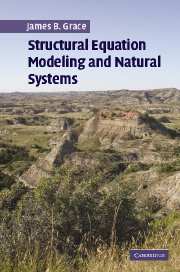Book contents
- Frontmatter
- Contents
- Preface
- Acknowledgments
- PART I A BEGINNING
- PART II BASIC PRINCIPLES OF STRUCTURAL EQUATION MODELING
- PART III ADVANCED TOPICS
- PART IV APPLICATIONS AND ILLUSTRATIONS
- 8 Model evaluation in practice
- 9 Multivariate experiments
- 10 The systematic use of SEM: an example
- 11 Cautions and recommendations
- PART V THE IMPLICATIONS OF STRUCTURAL EQUATION MODELING FOR THE STUDY OF NATURAL SYSTEMS
- Appendix I Example analyses
- References
- Index
8 - Model evaluation in practice
Published online by Cambridge University Press: 04 December 2009
- Frontmatter
- Contents
- Preface
- Acknowledgments
- PART I A BEGINNING
- PART II BASIC PRINCIPLES OF STRUCTURAL EQUATION MODELING
- PART III ADVANCED TOPICS
- PART IV APPLICATIONS AND ILLUSTRATIONS
- 8 Model evaluation in practice
- 9 Multivariate experiments
- 10 The systematic use of SEM: an example
- 11 Cautions and recommendations
- PART V THE IMPLICATIONS OF STRUCTURAL EQUATION MODELING FOR THE STUDY OF NATURAL SYSTEMS
- Appendix I Example analyses
- References
- Index
Summary
The contribution of model evaluation to scientific advancement
In Chapter 5 I described how the estimation process allows for evaluations of model fit. Such evaluations form the core of SEM. In the last section of this book I will go on to discuss how this contributes to the importance of SEM as a research tool. Briefly, I believe that because attention has been focused on univariate models, our theories have remained simplistic, emphasizing individual mechanisms rather than an understanding of systems. The evaluation of general ecological theories has also suffered from being very informal, with few rules agreed upon for deciding how evidence should be weighed in favor of one theory or another. This informality has often resulted in prolonged and unresolved debates (e.g., Grace 1991, Grimm 1994, Stamp 2003); signs of an immature scientific process in operation.
In this chapter I will present a few examples of the evaluation of structural equation models that have been applied to natural systems, relying on the methods presented in Chapter 5. As mentioned in the earlier discussion of SEM principles, we must always be cognizant of the fact that results and conclusions from SEM are dependent on the appropriateness of the model specified. As was illustrated earlier and as will be shown in some of the chapters that follow, inappropriate models can produce results that are quite misleading.
The current chapter is important because it describes some of the procedural steps involved in arriving at our best approximation of the correct model.
- Type
- Chapter
- Information
- Structural Equation Modeling and Natural Systems , pp. 207 - 232Publisher: Cambridge University PressPrint publication year: 2006
- 1
- Cited by



